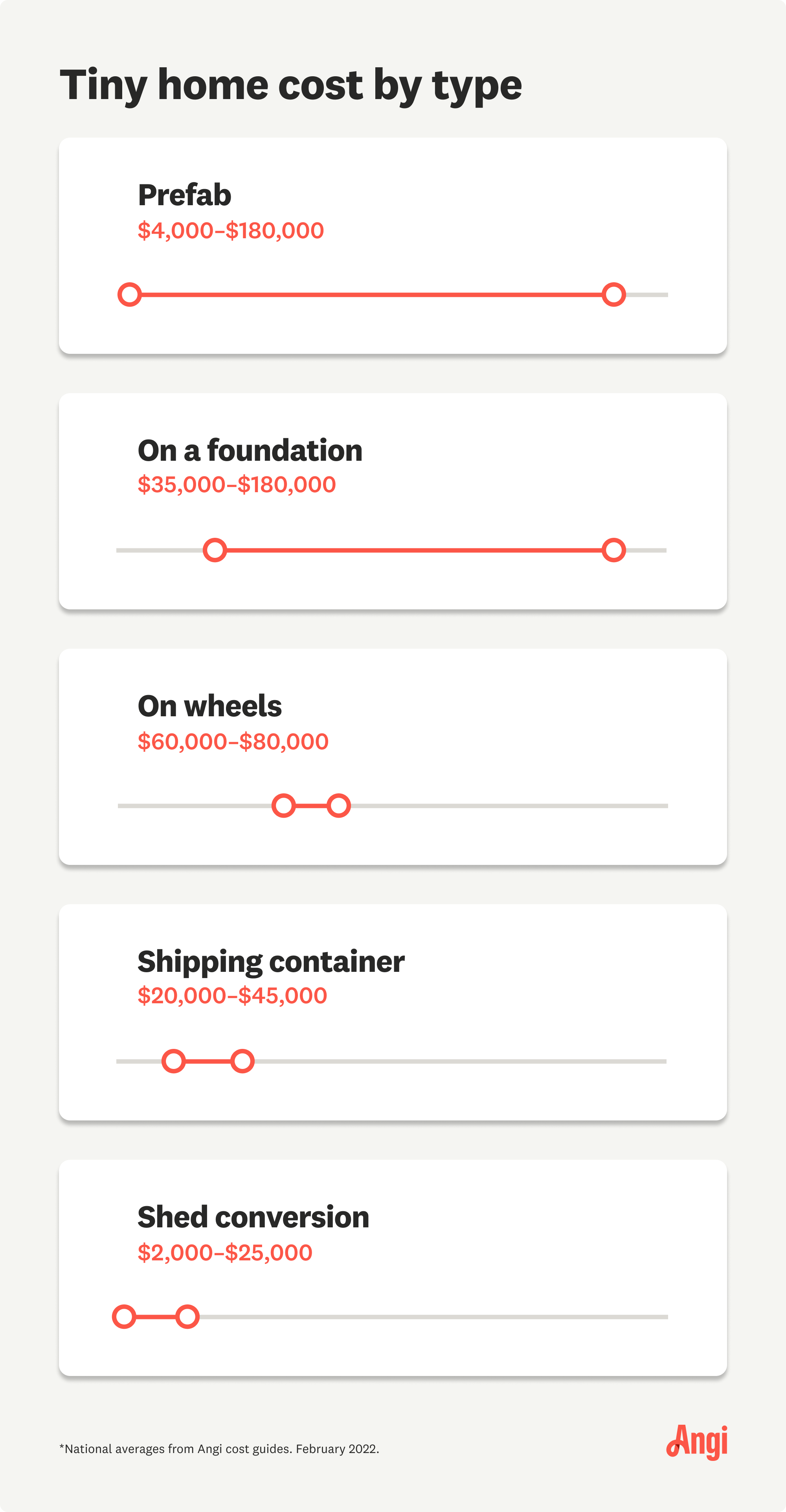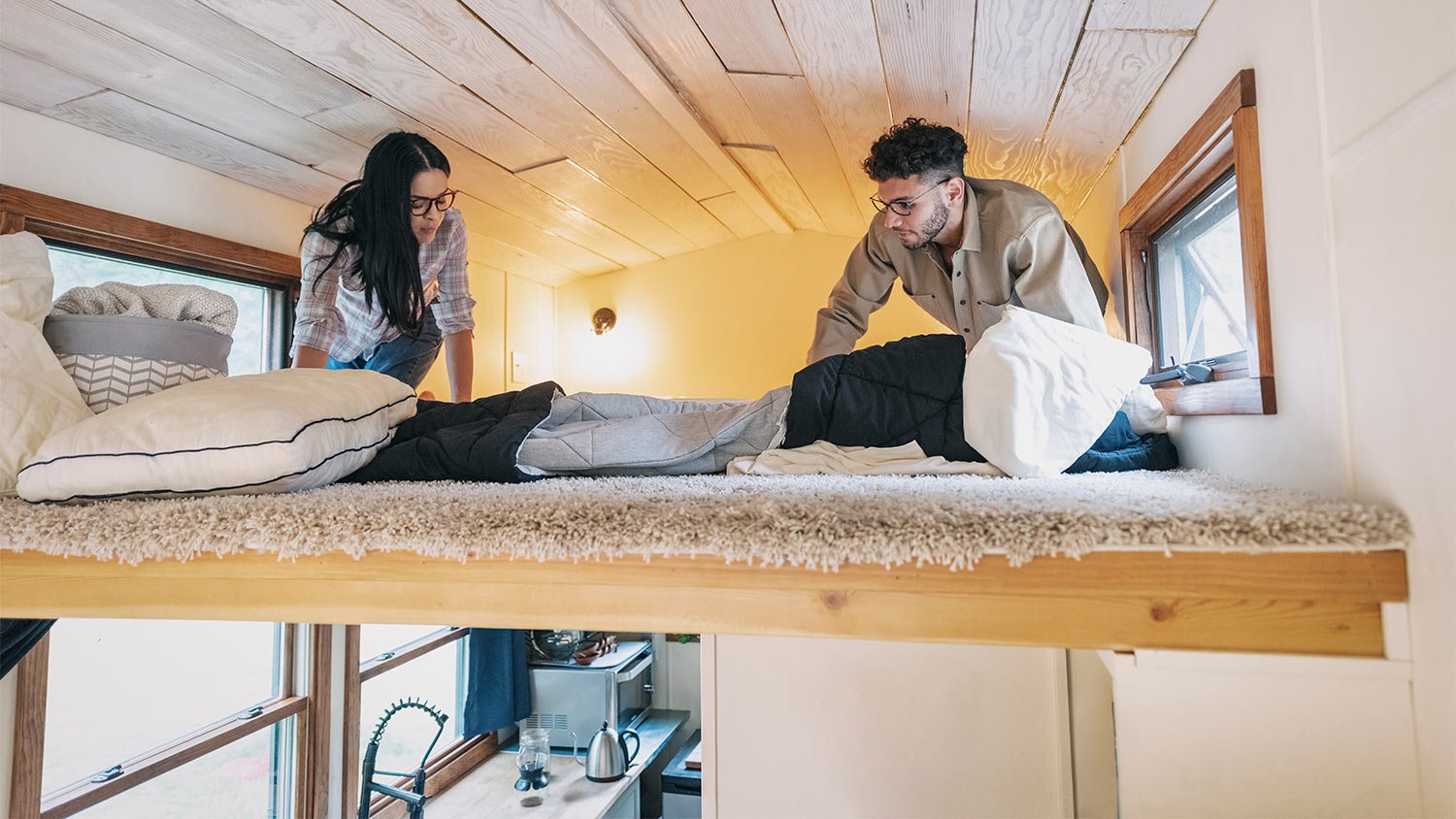How Much Is the Real Cost of Tiny Homes?
A tiny house costs $45,000 on average, depending on its size and features. Most spend between $30,000 and $60,000.


If you’ve always envied a minimalist or nomadic life, then look no further than the tiny home. Most tiny houses cost between $30,000 and $60,000, though high-end custom homes can reach up to $180,000 or more. A few factors impact the total cost, including the size, type of materials, and your location. Learn all about how much a tiny home costs to help determine if tiny house living is right for you.
How Much Does It Cost to Build a Tiny Home by Type?

Prefab Tiny Home
Prefab tiny houses cost anywhere from $4,000 to $180,000 or more. You'll find smaller homes with builder-grade materials on the lower end, and on the top end, custom models with high-end finishes.
If you buy a tiny house shell (the structure and outer frame), the cost is usually between $15,000 and $40,000. The inside is empty, so you'll need to design and build out the interior yourself. If you have the skills to finish the inside, a tiny home shell can be a more affordable option.
Permanent Tiny House Built on a Foundation
A permanent tiny house built on a foundation costs between $51,000 and $53,000 on average, though costs could go up to $180,000 or more. Building a foundation usually accounts for $5,000 to $8,000 of the project or between $4 and $7 per square foot. You can build a custom or prefab tiny home on a foundation.
If you’re building on a foundation, you'll need to buy land and get the proper permits. A local land surveyor can help inspect the land before you build, which usually costs around $500 to $750.
Tiny House on Wheels
The typical cost for building a tiny house on wheels (or a tiny house trailer) ranges from $60,000 to $80,000. You won't need to buy land, but you'll need a vehicle that can tow the weight and size.
Each state has its own transportation guidelines on the maximum size of a tiny house on wheels, so check municipal requirements when planning your build. Your tiny house on wheels must also be sturdy enough to withstand travel and movement, and fall within the maximum width and height requirements for traveling on public roadways.
Shipping Container Tiny Homes
Shipping containers can act as the shell of a tiny house and typically cost between $20,000 and $45,000. You can order shipping containers with completed interiors or start with the structure and finish the interior yourself.
Shed-to-Tiny House Conversion
Turning a shed into a tiny house typically costs between $2,000 and $25,000. Sheds are often between 100 and 200 square feet and can make a nice shell for a tiny home. You'll need to outfit the interior with features like a kitchen, bathroom, and sleeping space to make it move-in ready.
How Much Does It Cost to Build a Tiny House per Square Foot?

Tiny homes are usually less than 400 square feet, and the cost to build a tiny home averages around $150 per square foot, though project prices may vary and can be up to $300 or $400 per square foot. The floor plan, materials, and finishes impact the final cost.
Tiny House Cost Breakdown
The total cost of a tiny house is a combination of materials, labor, and land (if you’re building a permanent house on a foundation). Here are the main components that contribute to tiny home cost considerations.
Materials
Materials usually cost 30% to 50% of your tiny home’s expense or between $14,100 to $54,800 on average. Depending on the type of your tiny home, you’ll need to account for lumber, concrete, drywall, flooring, siding, roofing, and insulation.
Land
If you’re building a permanent tiny home, you’ll need to factor in the cost of the land. Check the zoning laws to ensure you’re permitted to build on the property.
Building Permits and Taxes
Building permits range from $400 to $2,300 and are contingent on the type of structure, size, and location. If you’re hiring a local general contractor to build your tiny house, the cost of permits is usually included in their quote. Property taxes and homeowner’s insurance also factor in the building type and size.
Utility Hookup
You may be able to hook your tiny home up to local water and electricity unless your tiny home is off the grid. In that case, you may need to install a septic system or composting toilet and utilize renewable energy sources, such as solar panels or wind turbines.
Appliances
While your new location could be wide open spaces, you may be downsizing your actual living space. Due to the dimensions of a tiny home, you might need to buy specific appliances—like a stove or washing machine—that fit the space.
“A great place to look for smaller appliances is at recreational vehicle (RV) suppliers,” says Bob Tschudi, Angi Expert and Raleigh, NC-based general contractor. “They’ve been designing and optimizing for tiny spaces for a very long time.”
Furniture and Furnishings
The couch and bed from your full-size home may not fit in your tiny home, so you should budget for some new furniture and other home accessories. Maximize each element by considering how it can serve as functional, hidden storage. Or consider how furniture pieces can be transformed for various purposes, such as turning a table and benches into a bed.
Storage
For everything else that you’d like to keep but doesn’t fit into your new tiny home, consider possible storage unit expenses.
Cost to Build a Tiny Home Yourself
Building a tiny home on your own usually costs between $14,100 and $54,800 for materials alone, plus labor, tools, permits, and the land or towing vehicle.
Constructing a tiny house takes particular precision and time due to the unique size and space requirements. Mistakes can be costly, and you’ll want to ensure your home is sound and sturdy, meets code, and stays on budget. So with all of the known and unknown moving parts in mind, DIY tiny house building is usually best left to those with building expertise, along with electrical, plumbing, HVAC, and engineering experience.
Cost to Build It Yourself vs. Hiring a Contractor
You can save approximately 30% to 60% of the total cost by doing the labor yourself, but experienced contractors can save you money and time over the long run with a quality build.
A professional tiny home builder can build a tiny house in 120 hours on average, while a DIYer often takes at least 480 hours. Find at least three local home builders to provide you with a tiny home estimate, so you can compare apples to apples and evaluate what building approach is right for you.
How to Save Money on a Tiny Home
There are a few key ways you can save money when building a tiny home:
Opt for a prefabricated shell, then finish the interior yourself, including kitchen installation, flooring, and painting.
Choose standard builder-grade materials instead of high-end finishes.
Hire a professional tiny home builder, but do some of the work yourself, such as painting or laying the bathroom flooring.
“There are a lot of clever ways to save money on a tiny home,” says Tschudi. “For example, you can make an enclosed bathroom with a sink that sits on top of the toilet tank. Not only do you save on plumbing costs, but you’ve freed up very scarce square footage.”
Frequently Asked Questions
Due to the expansion of the tiny house movement, you can usually find tiny houses to buy in your state. Prices range considerably based on size, style, and type. If you’re looking for a tiny home that’s move-in ready, you may be able to find a good deal to buy or a prefab dealer near you.
Tiny homes may depreciate and be more challenging to sell because of their size, customization, and unique space. If your tiny home is on wheels, depreciation can happen in the same way that cars and RVs do. If your tiny home isn’t structurally sound, the resale value will also be lower.





- Bathroom Remodeling
- Kitchen Remodeling
- Shower Installation
- Stair Installers
- Bathtub Installation
- Shower Door Installers
- Kitchen Design
- Bathroom Design Companies
- Storm Shelter Builders
- Pre-Made Cabinets
- Kitchen Refacing
- Bathtub Replacement
- Ceiling Tile Installation
- Suspended Ceiling Companies
- Residential Designers
- Stair Builders
- Remodel Designers
- Shower Enclosures
- Home Renovations
- Kitchen Renovations
- Garage Remodeling
- Grab Bar Installation
- Walk-In Tub Installers
- Tub to Shower Conversion
- Balcony Contractors











